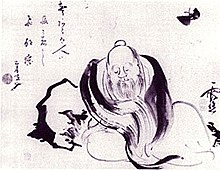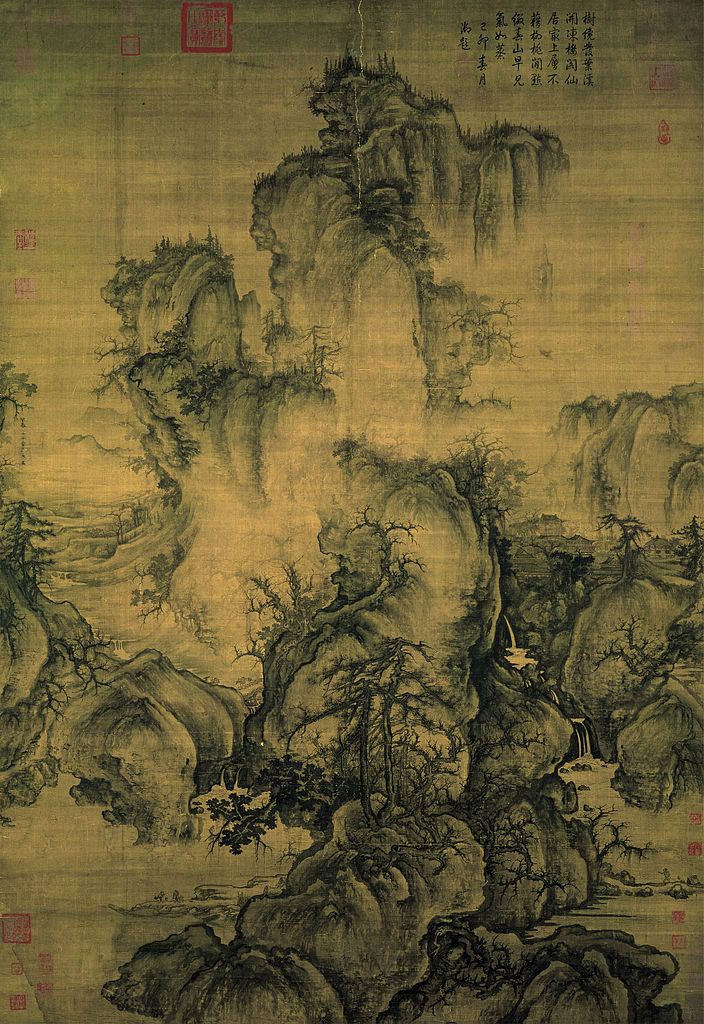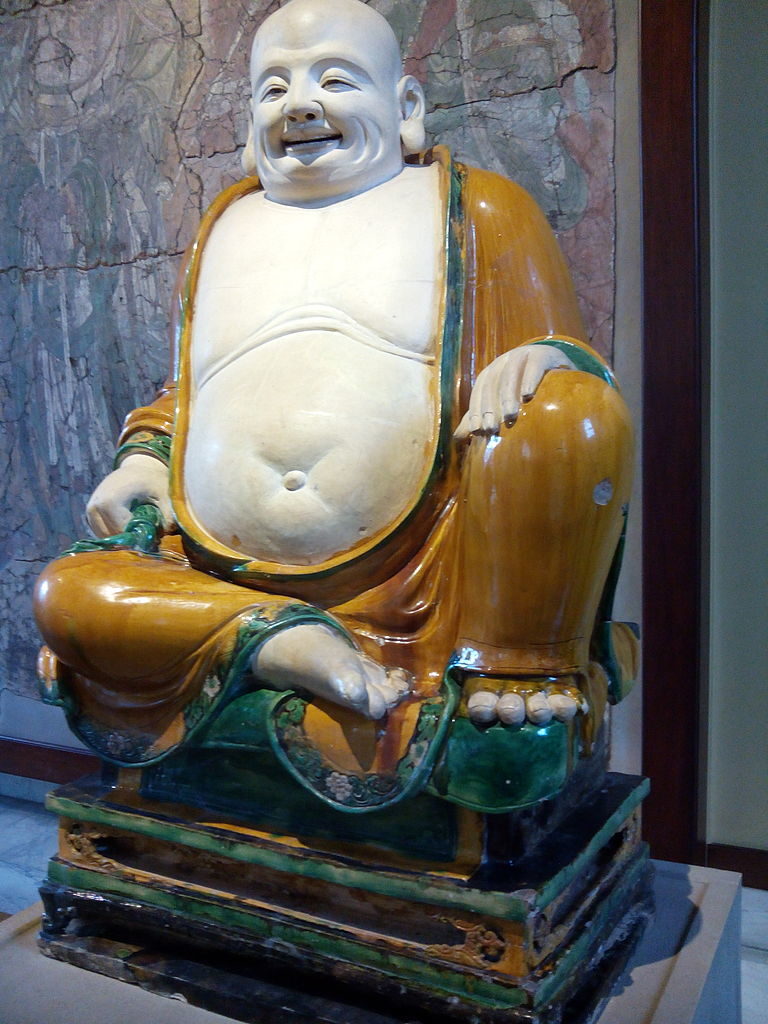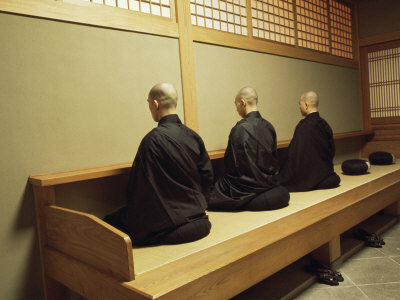The interpenetration of phenomena as the noumenon
A revolutionary move: phenomena restored to respectability

The original aim of the Hua-yen thinkers had been to syncretise the various Buddhist doctrines which had entered China since the beginning of the first millennium. What the Hua-yen school is best known for, however, is the doctrine of “mutual identity and interpenetration of all phenomena,” traditionally illustrated by the metaphor of Indra’s net. This doctrine is an elaboration of the Buddha’s doctrine of co-dependent origination, which Nagarjuna had equated with emptiness when he wrote: “It is dependent origination that we call emptiness.” Fa-tsang (Fazang, Tang Dynasty – 643-712), the third patriarch of the Hua-yen school and its main theoretician, broadened the ancient doctrine by adding a vertical dimension to the horizontal co-dependence of each particular phenomenon on other particular phenomena: that of the co-dependence of each phenomenon with the whole. This reinterpretation, patterned on the Daoist concepts of li, seen as an underlying principle, “empty of fixed form,” giving rise to phenomena (shi or shih) led to the assertion that “each phenomenon contains the whole.” This move proved to be a revolutionary one in the context of Buddhism, as it raised the status of the interpenetration of phenomena to that of a noumenon without turning emptiness into a Brahman-like essential Being. This allowed the Hua-yen school to turn the Indian’s world-negative approach into a world-affirmative engagement with phenomena, now restored to “respectability.” The Hua-yen universe is one “in which phenomena have been not only restored to a measure of respectability, but indeed have become important, valuable, and lovely” (Francis H. Cook, quoted by Jin Y. Park).
The renowned mythologist Joseph Campbell once summed up the difference between the Indian and Chinese apprehension of the world in a short formula: in India, “all is illusion: let it go,” in China,“all is in order: let it come”; in India, enlightenment (samadhi) with the eyes closed; in Japan [in fact, in all of East Asia], enlightenment (satori) with the eyes open.”
Hua-yen as a Chinese Buddhist school
The Avatamsaka Sutra, which the Hua-yen school took as its foundational text, is, as most Mahayana sutras, a collection of originally independent texts. In the case of the Avatamsaka, most of these texts were composed in Central Asia, most probably in Khotan, or even in China itself. Only two texts are now extant in Sanskrit. The sutra, which is massive – 60 volumes – covers the ten stages of the Bodhisattva’s progress. Though Fa-tsang himself grew up in Chang’an, the Tang Dynasty’s capital, his family had emigrated from Samarkand, in Sogdiana, then part of the Iranian cultural zone. The other four founding patriarchs of the school were born in China.
Cook provides a fascinating analysis of the succession of shifts in interpretation which led to a radical overhaul of Buddhist teachings.
A totalistic view of existence
Of all the Chinese cultural influences which shaped the re-interpretation carried out by Fa-tsang, the most crucial in Cook’s assessment was “the strong tendency to take what has been called a totalistic view of existence.” Indian Buddhism tended to focus on the “discrete individual” which it saw as “locked up within the boundaries of its own skin.” Its first step was to show that this isolation arose from the erroneous belief in the independent existence of all beings. Though encouraging an opening up to interconnectedness, the original standpoint was particularistic – the path was to lead from the particular to the totality. Chinese, on the other hand, had developed a totalistic standpoint around the notion of the Dao, seen as emptiness, as well as source and path of life energy shaping all phenomena. Though Daoist emptiness (wu) is different from Buddhist emptiness (sunyata), there was an affinity there, allowing for a bridge to be built. In India, emptiness was firmly asserted as anatman, not Atman, not Brahman, that is, in the strongest terms, not what was then referred as svabhava, an independent essence or substance! The nonbeing of the Dao provided Fa-tsang with the totalistic standpoint which essential Brahman could not offer Indian Buddhism.

In China, the totalistic standpoint was especially emphasised in the writings of the Neo-daoists, active during the 3rd to 6th centuries, so, just preceding Fa-tsang’s lifetime. It had, however, already been present in the writings of Chuang-tzu (Zhuangzi, 3rd century BCE). Kuo Hsiang (Guo Xiang, died in 312 CE), who “redacted” Chuang-tzu’s texts, rearranged them into 33 chapters, and enhanced them with philosophical commentaries, provides us with the example of an enquiry carried out from a totalistic standpoint. Asking what is prior to things, Kuo Hsiang writes: “We may say that the supreme Tao is prior to things. But this supreme Tao is supreme non-being (wu). Since it is non-being, how can it be prior? Thus, what can it be that is prior to things? And yet things are continuously being produced. This shows that things are spontaneously what they are. There is nothing which causes them to be such” (quoted by Cook).
Cook regards this refusal to look for an external creative agency as “a strong foreshadowing of the later Hua-yen doctrine of the self-creation and self-transformation of a universe which for all practical purposes is beginningless and endless.” Also foreshadowing the Hua-yen doctrine is Kuo-hsiang’s emphasis on the whole universe and each of its parts, as well as the importance of the apparently insignificant when he writes that “when a man is born, insignificant though he be, he has the properties that he necessarily has. However trivial though his life may be, he needs the whole universe as a condition for his existence. All things in the universe, all that exist, cannot cease to exist without some effect on him. If one factor is lacking, he might not exist. If one principle is violated, he might not be living” (emphasis by Cook).
In fact, a direct influence cannot be excluded, as it said that in the holographic Hua-yan universe, each part reflects the pattern of the whole, so “everything counts.” No part can be taken away without affecting the whole.

The respect for, and even delight in, the natural
“The respect for, and delight in, the natural … is a a persistent trait in Taoist thought, and is nowhere as evident as in the poems and landscape paintings of the Taoists and Ch’an devotees. It is an element which is absent from Indian Buddhism, where there was, to say the least, little affection for the natural” (Cook). It is as if the landscape, especially lofty peaks, waterfalls, and winding rivers, seemingly emerging from emptiness, represented the universe itself, an organic and dynamic whole, where things are self-creating, alive, and radiating joy. Humans may be present in the grandiose landscape, but they are never the main focus. It may in fact take some time before a human figure can be spotted in the intricate details of the artwork! Indian Buddhist art had instead focused on the sitting or standing Buddha, meditating or teaching.
Daoists saw the natural as the spontaneous, what arises of itself, and valued it as the perfect. When a culture posits a transcendent deity as the origin of the order ruling the cosmos, humans see themselves and phenomena as imperfect copies of the divine order. Though China had a concept of Heaven as a transcendent authority, Daoists seem to have retained the more ancient concept of an immanent nature, which led them to take natural phenomena as the norm for perfection. How could humans do better than what already existed? Human attempts at deliberately intervening are unwelcome, and regarded as interferences with the spontaneous unfolding of reality. This is the meaning of wu-wei (noncoercive action), wu-xin (unmediated thinking), and all the other wu forms. Wu (emptiness) here means “empty of willful self.”
As a consequence, as Cook notes, Chinese Buddhism soon came to “interpret the Buddhist goal of enlightenment as a return to naturalness … By a return to the “source,” which is that innate ability to respond innocently and in a childlike manner to experience, the individual transcended those maddening contraries of “is” and “is not” which Chuang-tzu spoke of, and learned the difficult art of noncalculating action, or the nonaction in action which in Chinese is called wu-wei.”

Buddhist enlightenment had often been described as “seeing things as they (truly) are.” Indian Buddhist teachers explained this as “seeing things as interdependent, the products of conditions,” in other words, impermanent, not really real as things were changing all the time. One could never get hold of them. It was a warning against getting attached to them, and as such reflected a negative judgment on their value. With Chinese culture accepting change as such as the law of the universe, and the arising of the “ten thousand things” as representing the spontaneous creative impulse of nature, “seeing things as they are” came to mean seeing things as natural, the perfect, the good. And this led to a celebration of the simple and the ordinary. Cook notes that in India, the realised being is “dressed in a manner befitting royalty,”with the robes of a prince, elaborately arranged hair, and hanging jewels. In China, the saint is “best portrayed in the figures of Pu-tai … fat, jovial, and totally relaxed. He is barefooted and his hair and clothes (more like rags) are in negligent disarray. He obviously enjoys plum wine and a good mean; there is nothing of the renunciant about him” (Cook). As it is often said, “to live a Zen life is to live an ordinary life.” The return to the ordinary is a return to the naturally perfect. “The Buddha-dharma has no special place to apply effort. It is only the ordinary and everyday; relieving one-self, donning clothes, eating rice, lying down when tired. The fool laughs at us, but the wise understand” (Lin-chi quoted by Nishida).
Wu (non-being), Li (natural law) and Shi (phenomena)
Behind the move towards a totalistic worldview and its identification with the natural, a reinterpretation of the foundational concepts of Indian Buddhism had taken place, using parallel ideas in the Chinese, especially Daoist understanding of reality. Peter Harvey explains: “Using a well-established pair of Chinese ideas, the Dharma-realm is said to be the underlying “principle” or “noumenon” (Ch. li) which interpenetrates “phenomena (shi or shih) as they do each other … Phenomena are empty, but are not unreal; for they are no different from li. Phenomena are seen as radically interrelated, and thus empty of inherent nature, much as in Madhyamika thought, but as well as this “horizontal” relationship between phenomena, there is also their “vertical” relationship with li, the Tathagata-garbha conceived as like the ever-malleable Dao.” Because the Daoist view of reality is dynamic, li is conceived as an activity, rather than a substance. “Li is not static and unchanging, but fluid and without any fixed form, like the Dao. It is a kind of “emptiness,” but now in the sense of something which is empty of fixed form, and so full of countless possibilities” (Harvey). It is impossible not to compare this ancient East Asian insight with quantum physics’ claim that matter can manifest as either mass or energy. Science, however, remains caught up in the duality of subject and object, reality as viewed from the outside, for us to use to boost technology and more efficiently exploit nature as a resource!
Thanks to Daoism, Buddhism grew stronger, swapping its negative assessment of phenomenality as troublesome impermanence for its positive equation with the spontaneous creativity of nature, forever producing phenomena that are “valuable and lovely.”
But Daoism also received a boost from Buddhism. Though Daoism had developed complex alchemical practices, derived from the same shamanic techniques as the yogic practices the Buddha had used in meditation, one does not find in Daoism the equivalent of the arduous exploration of the processes of consciousness carried out by the thinkers/meditators of the Madhyamika, Yogacara and Tathatagatagarbha schools. Buddhism therefore brought the Chinese a more sophisticated grasp of the way the “mind,” operates, and a set of practices to ensure that no ego-driven distortions come in the way of the arising of the world’s “countless possibilities.”
A positive view of phenomenality
Cook writes: “The genius of the Chinese lay in their ability to interpret emptiness in a positive manner without hypostatizing emptiness, without falling into the error of even greater attachment to the world, and without abandoning the basic Buddhist conviction that ordinary experience is delusive and destructive.” It is remarkable that, whereas Buddhism sought a cessation of suffering through an escape from reincarnation, Daoism focused instead on a quest for immortality, or at least a longevity that implied a long stay in the incarnated state, that is, the very exact opposite of an escape. Such a positive attitude towards the world may well have been that of pre-literate shamanistic cultures which, though retained in India by the Ajivikas, and their scheme of 72,000 incarnations, had been lost by the Jains and the Buddhists. Having survived in China in the Daoist worldview, this positivity came to be restored to Buddhism only a few centuries after its establishment there. The dialogue between the Buddhist and Daoist worldviews allowed Fa-tsang to conceive a positive view of the universe “in which any dharma [“thing” or, better, “event”] acts as a necessary support for the others, the upshot of which is that any phenomenon must be viewed as having an absolute value in the nexus of interdependence.” What Indian Buddhism had achieved by “reducing all things to the common level of insignificance” as preemptive method to prevent attachment – “is attained in Hua-yen by raising all things to the common level of supreme value,” that is, depicting them as the joyous emergence of phenomena out of emptiness (Cook).
Cook adds that “Hua-yen goes even beyond this position, holding that everything, animate and inanimate, possesses Buddha nature … [in fact] it is not a question of things possessing Buddha-nature, all things are Buddha-nature.”
Hua-yen for philosophy, Ch’an/Zen for practice
Tsung-mi (Guifeng Zongmi, 779-840), the last patriarch of the Hua-yen school, was also a master in the Ch’an school. The lineage of the Hua-yen school was brutally interrupted in 845 by a period of persecution against Buddhism which was, ironically, instigated by a Daoist emperor. This, fortunately, did not stop Hua-yen from becoming very influential in the countries neighbouring China, such as Korea and Japan. It became especially associated with the Ch’an school, hence the saying “Hua-yen for philosophy, Ch’an for practice.” The statement may surprise, since Ch’an describes itself as “a special transmission outside the scriptures, not founded upon words and letters.”And what is Hua-yen, if not one of the most complex system of “words and letters” ever put together? What the saying means is that “the picture of existence presented by Hua-yen is the universe experienced in Zen enlightenment. Without the practice and realization of Zen, Hua-yen philosophy remains mere intellectual fun, never a vibrant reality. Hua-yen, in turn, serves as an intriguing lure to the practitioner, a stimulus to effort, and a promise of a vision undreamed of in our more common hours” (Cook).
Practice ensures that this Hua-yen image of a mutual interpenetration of phenomena is fully “embodied,” and becomes as spontaneous and natural as breathing.
Sources
Francis H. Cook – Hua-yen Buddhism – The Jewel Net of Indra (1977)
Jin Y. Park- Buddhism and Postmodernity – Zen, Huayan, and the Possibility of Buddhist Postmodern Ethics (2008)
Joseph Campbell – Oriental Mythology (1962)
Peter Harvey – An Introduction to Buddhism: Teachings, History and Practice (2013)
Nishida, Kitaro – An Inquiry into the Good (English translation 1990)

Anyone interested in a reformulation of Buddhist thought in the language of Western philosophy may have a look at my other blog, dedicated to Nishida Kitaro, Nishitani Keiji and Ueda Shizuteru:
https://thekyotoschoolofphilosophy.wordpress.com
